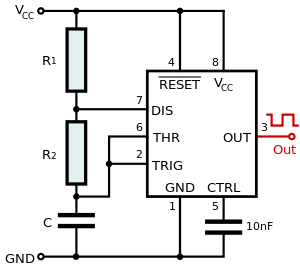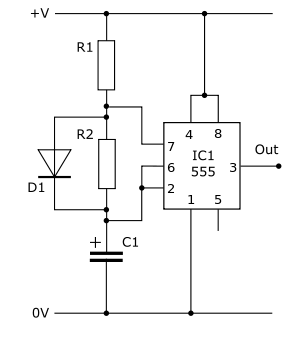The 555 timer IC provides a very versatile, effective, and easy-to-use astable mode. By changing component values, one can get frequencies from a maximum of about 300KHz to as low as limited by the leakage of the capacitors used in the circuit. It can also have the mark-space ratio altered almost limitlessly.
Basic Circuit
The basic 555 astable circuit is set up like this.

- At higher frequencies and loads, it is advisable to put a 100nF capacitor between Pin 5 and 0V.
The frequency and mark-space ratio are defined by the values of R1, R2 and C1 only. For a roughly even (1:1) mark-spce ratio, R1 is usually set at 1K, and the other resistor (R2) and capacitor are changed to alter the frequency. If better control over the mark-space ratio is required, use the next circuit.
Design equations
- .
There is an online calculator here that will give the frequency, high time and low time for a given set of components.
Variable mark-space ratio
This variation allows much easier control of the mark-space ratio without too much impact on the frequency. The only difference is a diode between Pins 6 and 7, with the cathode at Pin 6. The effect of this is to shunt resistor R2 when charging C1. This means that C1 charges though R1 only. This removes R2 from the "high-time" equation, and make calculating the mark-space ratio easier and prevents the frequency from being altered excessively by changes in the mark-space ratio ( although this still happens to a certain extent).

Design equations
- .
- This is different to the design equation for the standard 555 Astable. (R2 instead of 2R2)
Mini-astable
This astable uses fewer components than the basic astable, and requires only the IC, one resistor and one capacitor, plus the Pin 5 capacitor for final versions.

This astable has a MSR of approximately 1:1, but this tends to increase under heavy current load, as the output does not swing fully to the power supply. This astable is not a reliable source of frequency, and should never be used where an accurate, stable clock is needed.
Design equations
- .
Pin 4 Enable
Pin 4 is normally held high, and in this state it does nothing. However, when Pin 4 is brought low, the 555 is disabled, and the output is held low. This can be used to turn an astable on when desired. An example of this is the double-astable bleeper, which uses the output from one astable to enable another, faster astable.
Pin 8 should not be used as the enable pin, as this will draw all the current needed to run the device from the triggering circuit.
Other astable circuits
Units of Design Equations
The units that the components values and frequency are measure in are the standard base units: ohms, farads and hertz. This are often inconvenient, as the value for componets are usually several orders of magnitude away from the base unit. It is possible to use more conveninet units to calculate the frequency, and the common combinations are given below:
| Resistance | Capacitance | Period | Frequency |
|---|---|---|---|
| Ω | F | s | Hz |
| MΩ | μF | s | Hz |
| kΩ | μF | ms | kHz |